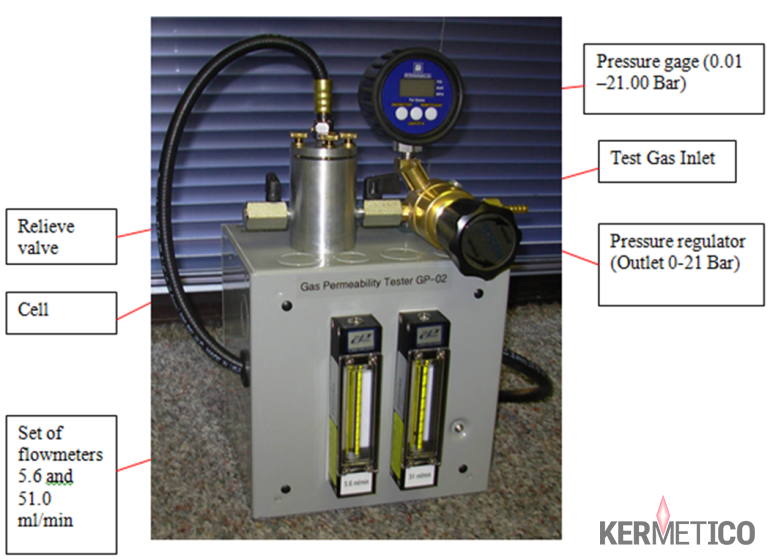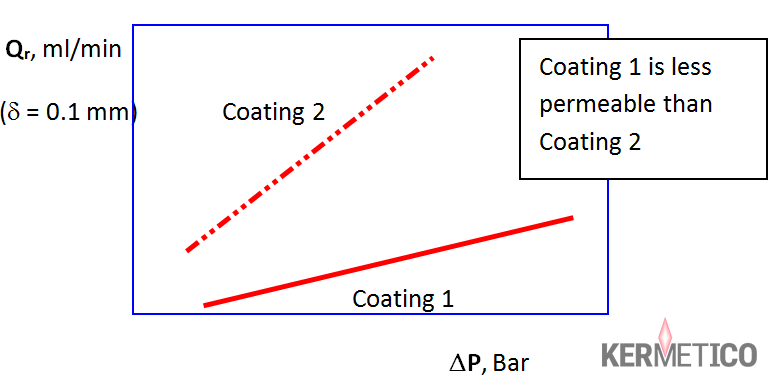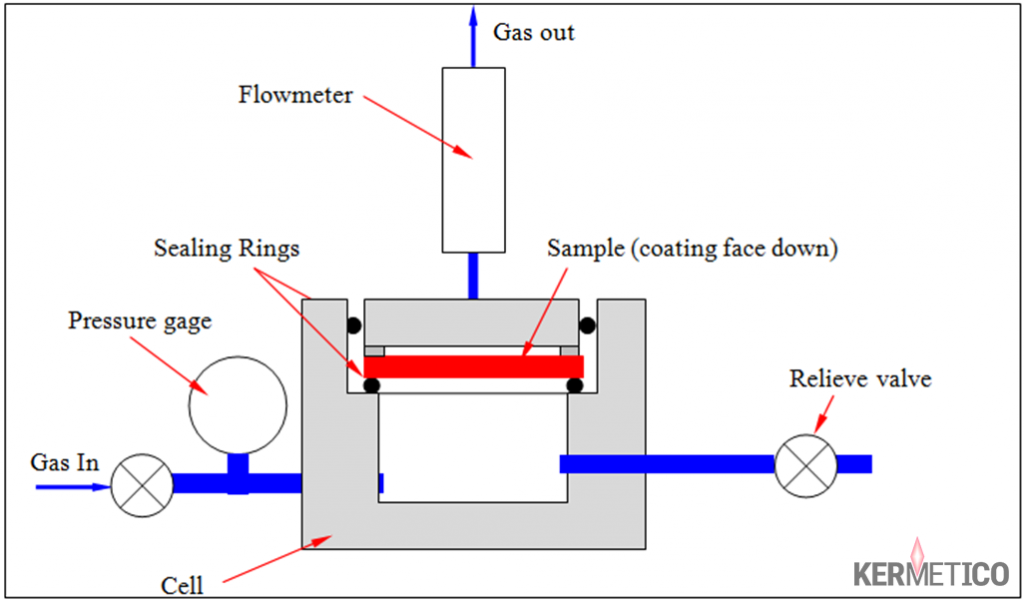A Gas Permeability Tester For Thermal Spray Coatings Through Porosity Measurement
We have designed our Coating Gas Permeability Tester to measure the degree of gas permeation through a coating due to the coating through porosity and other interconnected defects.
Conventional methods for the evaluation of thermal spray coating porosity are qualitative.
A metallographic porosity check is quite long, expensive and is a subject to mistakes due to poor specimen preparation or interpretation.
The quantitative gas permeability test allows one to measure porosity in minutes, even in field conditions.
Do you want to know the best part?
You do not need to machine samples after spraying them.
You do not need electricity, glue, polishing materials, etc.
Just the sample disc and nitrogen.
The Procedure For Gas Permeability Testing
The process is easy:
- Spray the sample disc
- Test for gas permeability
- Calculate the result
- Save the sample for the future reference
The Principle Of Coating Gas-Permeability Testing
The Presentation Of Results
- Total flow rate Q at fixed pressure drop DP for a fixed coating thickness
- Plotting of the graph “Gas flow rate Qr versus pressure drop DP”
The flow rate Q through the sample of known thickness (or the flow rate Qr, reduced to the standard sample thickness, for example, 1 mm, 0.1 mm, etc.) is plotted against the pressure drop DP. This graph is a final result of the measurements:
Calculating The Coefficient Of Viscous Gas Permeability
The calculation is based on the following assumptions. For gaseous fluids and materials with very small pore size, the inertia flow is negligible, and the flow is regarded as strictly viscous when Darcy’s law applies [2]:
DP / d = Q * h / (A * Y n) , (1)
or
Y n / d = Q * h / (A * DP)
where:
- DP is the pressure gradient (Pa);
- d is the thickness of the test piece (m);
- A is its cross-sectional area (m2);
- h is the dynamic (absolute) viscosity of the test fluid (Pa * s);
- Q is the volumetric flow rate of the fluid (m3 / s);
- Y n is the viscous permeability coefficient (m2).
The viscous permeability coefficient Y n has the physical meaning of the area of through pores in a 1 m2sample. In the Q – DP graph, it is the tangent of the line slope.
It is convenient to present the results of Y n measurement in square nanometers (nm2).
The Gas Permeability Measurement Procedure
The coating sample of 50-600 microns (2-24 mils) thickness is sprayed onto a porous stainless steel disc (25 mm (1”) diameter, 3 mm (1/8”) thick, 2-micron average pore size).
Both sides of the sample are sealed with rubber O-rings (grease the O-rings for each measurement), forming a 19 mm (3/4”) diameter open (working) area, the coating sample is placed into the tester cell (coating face down). Nitrogen under controlled pressure (0.01 – 21.00 Bar- 0.15- 305 PSIG) is introduced into the cell under the coating, while the gas flow rate is measured above the coating (Fig. 2). The dependence of gas flow rate trough the coating on the cell pressure plotted as a graph, characterizes the coating gas permeability.
The flow rate is calculated for 1 cm2 area and similar coating thickness for compared samples. The recommended coating thickness is about 0.05-0.10 mm (0.002”-0.004”) for dense coatings, and about 0.4 mm (0.016”-) for porous coatings. Coating thickness must be measured with a micrometer to use its value in the calculations.
The viscous permeability coefficient Y n (nm2) is calculated from (1) as:
Y n = 7783 Q * d / DP,
where:
- Q is flow rate, cm3/min (ml/min)
- d is coating thickness, cm
- DP is gas pressure drop, Bar
assuming, the sample area is 2.3 cm2; m (gas dynamic viscosity) =0.0179 cp = 1.79 * 10-5 Pa * s (for air and nitrogen).
Alternatively, total flow at a fixed testing pressure drop and a fixed coating thickness is used as a quick reference for coating quality control.
Two flowmeters are supplied for measurements with the standard Gas Permeability Tester:
- HVOF and HVAF coatings: full scale 5.6 ml/min for nitrogen
- Plasma and electric arc sprayed coatings: full scale 51.0 ml/min for nitrogen.
Permeability Testing Results Presentation
The results are presented as one of the following:
- total gas flow rate Q (ml/min) at fixed pressure gradient DP (Bar) (for instance, for quality control purposes)
- the graph of the gas flow rate Q (ml/min) versus the pressure gradient DP (Bar) for a 1 cm2 coating area and 0.1 mm (0.004”) coating thickness;
- the viscous gas permeability coefficient Y n (nm2).



